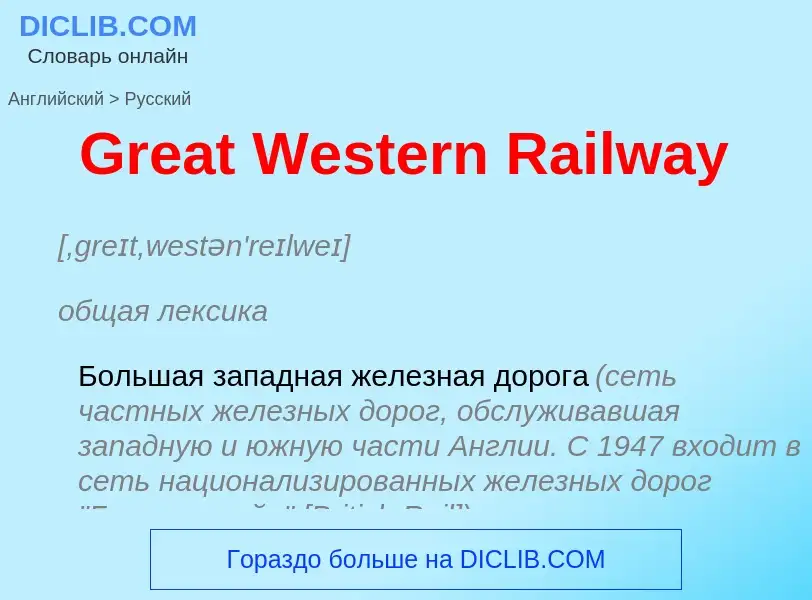Translation and analysis of words by ChatGPT artificial intelligence
On this page you can get a detailed analysis of a word or phrase, produced by the best artificial intelligence technology to date:
- how the word is used
- frequency of use
- it is used more often in oral or written speech
- word translation options
- usage examples (several phrases with translation)
- etymology
Great Western Railway - translation to russian
[,greɪt,westən'reɪlweɪ]
общая лексика
Большая западная железная дорога (сеть частных железных дорог, обслуживавшая западную и южную части Англии. С 1947 входит в сеть национализированных железных дорог "Бритиш рейл" [British Rail])
Definition
Wikipedia
The Great Western Railway (GWR) was a British railway company that linked London with the southwest, west and West Midlands of England and most of Wales. It was founded in 1833, received its enabling Act of Parliament on 31 August 1835 and ran its first trains in 1838 with the initial route completed between London and Bristol in 1841. It was engineered by Isambard Kingdom Brunel, who chose a broad gauge of 7 ft (2,134 mm)—later slightly widened to 7 ft 1⁄4 in (2,140 mm)—but, from 1854, a series of amalgamations saw it also operate 4 ft 8+1⁄2 in (1,435 mm) standard-gauge trains; the last broad-gauge services were operated in 1892.
The GWR was the only company to keep its identity through the Railways Act 1921, which amalgamated it with the remaining independent railways within its territory, and it was finally merged at the end of 1947 when it was nationalised and became the Western Region of British Railways.
The GWR was called by some "God's Wonderful Railway" and by others the "Great Way Round" but it was famed as the "Holiday Line", taking many people to English and Bristol Channel resorts in the West Country as well as the far southwest of England such as Torquay in Devon, Minehead in Somerset, and Newquay and St Ives in Cornwall. The company's locomotives, many of which were built in the company's workshops at Swindon, were painted a Brunswick green colour while, for most of its existence, it used a two-tone "chocolate and cream" livery for its passenger coaches. Goods wagons were painted red but this was later changed to mid-grey.
Great Western trains included long-distance express services such as the Flying Dutchman, the Cornish Riviera Express and the Cheltenham Spa Express. It also operated many suburban and rural services, some operated by steam rail motors or autotrains. The company pioneered the use of larger, more economic goods wagons than were usual in Britain. It ran ferry services to Ireland and the Channel Islands, operated a network of road motor (bus) routes, was a part of the Railway Air Services, and owned ships, canals, docks and hotels.

![First Great Western power car 43185]] First Great Western power car 43185]]](https://commons.wikimedia.org/wiki/Special:FilePath/43185 Nameplate.jpg?width=200)

![mixed-gauge]] track mixed-gauge]] track](https://commons.wikimedia.org/wiki/Special:FilePath/Baulk road point with side step.jpg?width=200)
![J. C. Bourne]]. J. C. Bourne]].](https://commons.wikimedia.org/wiki/Special:FilePath/Bristol Temple Meads railway station train-shed engraving.jpg?width=200)

![[[Maidenhead Railway Bridge]] [[Maidenhead Railway Bridge]]](https://commons.wikimedia.org/wiki/Special:FilePath/Brunel's Railway Bridge at Maidenhead - geograph.org.uk - 94793.jpg?width=200)
![Cheffin's Map]], 1850. The sweep to the north from Reading is clearly seen. Cheffin's Map]], 1850. The sweep to the north from Reading is clearly seen.](https://commons.wikimedia.org/wiki/Special:FilePath/Cheffin's Map - Route of Great Western Railway, 1850.jpg?width=200)



![Iron Duke Class]] locomotive ''Hirondelle'', built in 1848 Iron Duke Class]] locomotive ''Hirondelle'', built in 1848](https://commons.wikimedia.org/wiki/Special:FilePath/GWR Hirondelle.jpg?width=200)
![1934 [[camp coach]] brochure 1934 [[camp coach]] brochure](https://commons.wikimedia.org/wiki/Special:FilePath/GWR book Camp Coach Holidays.jpg?width=200)

![Helston}} to [[The Lizard]] Helston}} to [[The Lizard]]](https://commons.wikimedia.org/wiki/Special:FilePath/GWR bus AF84 on Helston service.jpg?width=200)



![A display commemorating [[Daniel Gooch]] at the [[National Railway Museum]] A display commemorating [[Daniel Gooch]] at the [[National Railway Museum]]](https://commons.wikimedia.org/wiki/Special:FilePath/National Railway Museum Daniel Gooch Fire Fly model.jpg?width=200)
![Turner]]. Turner]].](https://commons.wikimedia.org/wiki/Special:FilePath/Rain Steam and Speed the Great Western Railway.jpg?width=200)
![The [[Sonning Cutting]] in 1846 The [[Sonning Cutting]] in 1846](https://commons.wikimedia.org/wiki/Special:FilePath/Sonning cutting.jpg?width=200)
![[[Isambard Kingdom Brunel]]'s statue at Paddington station [[Isambard Kingdom Brunel]]'s statue at Paddington station](https://commons.wikimedia.org/wiki/Special:FilePath/Statue IKBrunel PaddingtonStn DMS 05122005-003-1.jpg?width=200)

![Iron Duke]]'''s tender: Holly green with pea green lining Iron Duke]]'''s tender: Holly green with pea green lining](https://commons.wikimedia.org/wiki/Special:FilePath/Iron Duke tender painting detail.jpg?width=200)
![City of Truro]]'': Middle Chrome green, orange lining and red frames City of Truro]]'': Middle Chrome green, orange lining and red frames](https://commons.wikimedia.org/wiki/Special:FilePath/GWR 3440 City of Truro - geograph.org.uk - 1479746.jpg?width=200)
![Nunney Castle]]'': Middle Chrome green, orange lining and black frames Nunney Castle]]'': Middle Chrome green, orange lining and black frames](https://commons.wikimedia.org/wiki/Special:FilePath/5029 Nunney Castle Didcot old slide.jpg?width=200)
![3850]]: Middle Chrome green, black frames but no lining 3850]]: Middle Chrome green, black frames but no lining](https://commons.wikimedia.org/wiki/Special:FilePath/Willtion 3850 token exchange.jpg?width=200)
